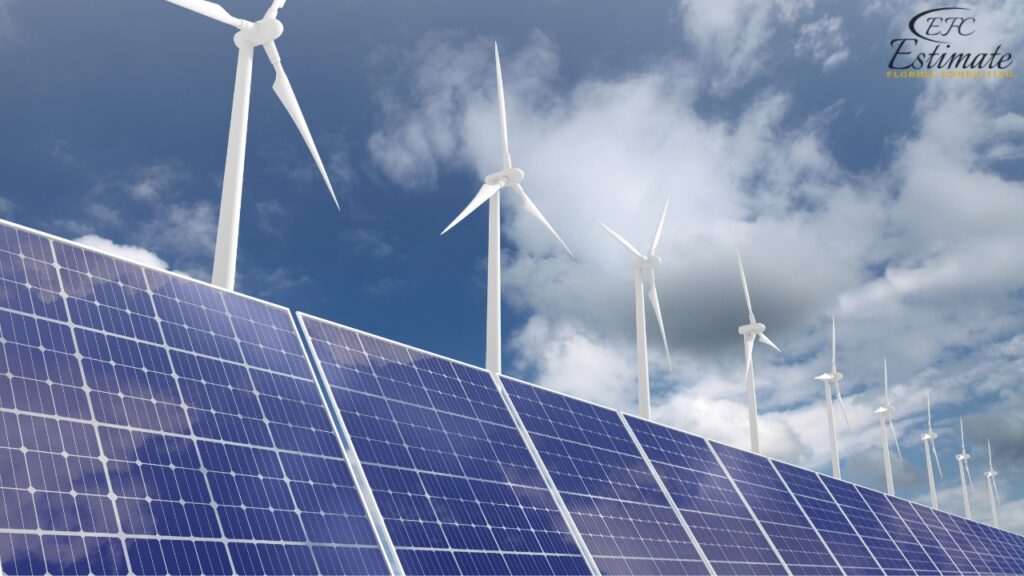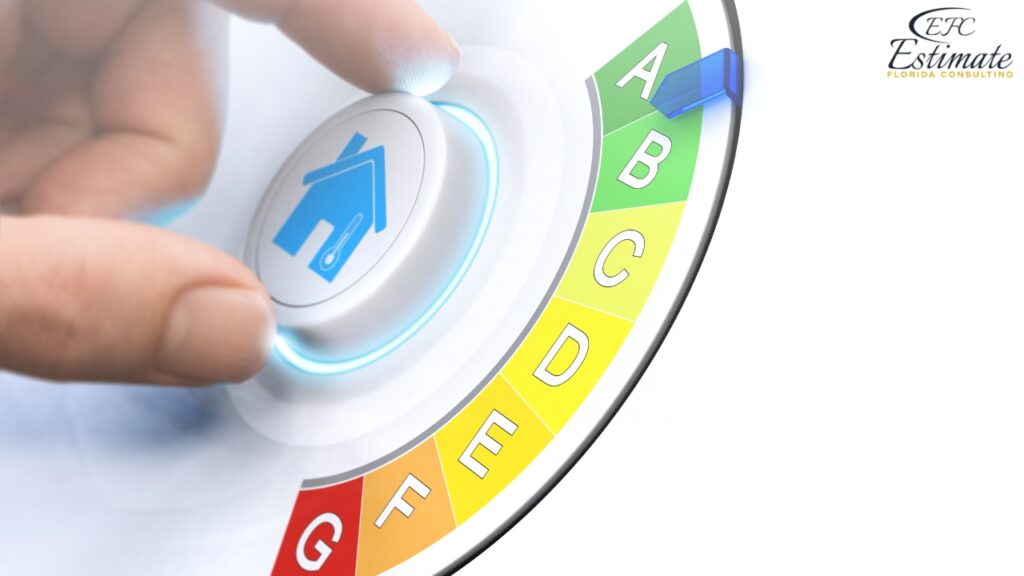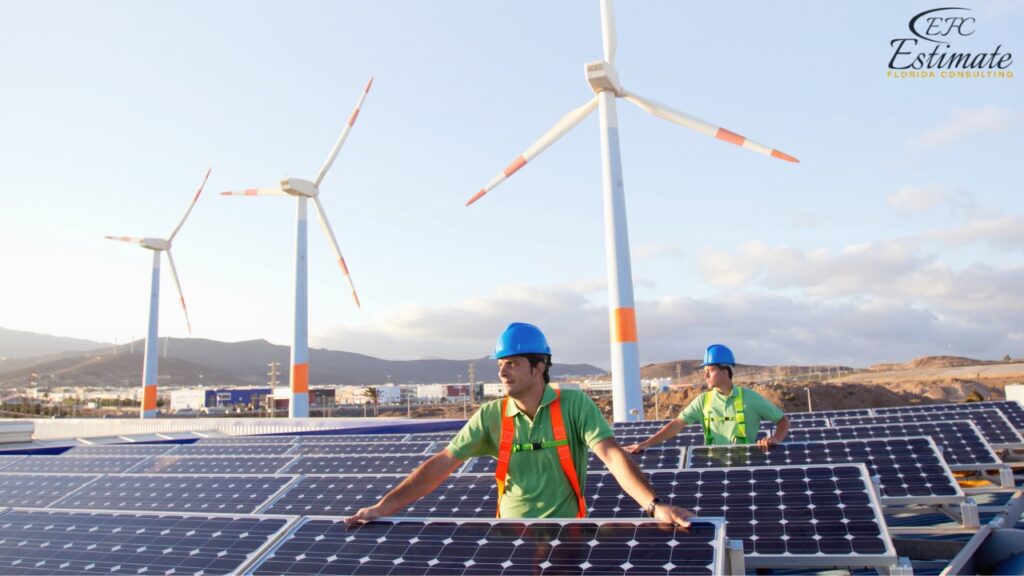Cost Of Commercial Building Energy Efficiency Upgrades
Upgrading your commercial building to be more energy efficient is a smart investment that can lead to significant savings and a more sustainable future. The total estimated cost for these energy efficiency upgrades ranges from $305,963 to $744,714, depending on the scope and scale of the project. This includes building upgrades, which can cost between $236,600 and $600,600 and might involve improvements such as better insulation and more efficient windows. Design and permits add another layer of costs, estimated at $41,517 to $89,514, ensuring that all upgrades meet necessary regulations and standards.

Additionally, incorporating advanced technology and automation systems, such as smart lighting and thermostats, can range from $27,846 to $54,600. Understanding these cost components helps in planning and executing an effective strategy to maximize energy efficiency and operational savings.
Key Factors Influencing Upgrade Costs
Size and Complexity of the Building
The size and complexity of the building significantly influence the cost of energy efficiency upgrades. Larger buildings require more materials and labor, while the complexity of the systems can affect the cost of design and installation. The building’s layout, age, and existing infrastructure also impact the scope and cost of the upgrades. Understanding the building’s unique characteristics helps set realistic expectations for timelines and costs. Complex building systems, such as multi-zone HVAC or integrated lighting controls, may require specialized expertise, increasing labor costs. Additionally, older buildings may face challenges related to outdated infrastructure, requiring more extensive renovations.
Cost Breakdown
Building Size (Sq Ft) | Estimated Cost Range |
10,000 | $182,000 – $254,800 |
20,000 | $254,800 – $364,000 |
50,000 | $364,000 – $546,000 |
Larger buildings might benefit from economies of scale, but they also require more resources for completion. By accurately estimating space requirements, businesses can optimize resource allocation and avoid unnecessary expenditures. Cost efficiency can be achieved by leveraging bulk purchasing for materials and negotiating competitive rates for labor, particularly in larger projects.
Type of Upgrades
The type of energy efficiency upgrades can influence costs based on the existing condition of the building and the desired outcome. Common upgrades include lighting retrofits, HVAC system improvements, insulation enhancements, and building envelope modifications. Each type of upgrade addresses specific energy efficiency areas and can involve different levels of complexity and expense. For instance, lighting retrofits may be straightforward and relatively low-cost, while HVAC upgrades might involve significant mechanical changes and higher expenses. Choosing the right mix of upgrades depends on the building’s unique needs and the owner’s energy reduction goals.
Cost Breakdown
Upgrade Type | Estimated Cost Range |
Lighting Retrofit | $10,920 – $18,200 |
HVAC System Upgrade | $45,500 – $91,000 |
Insulation Enhancement | $27,300 – $45,500 |
Building Envelope Improvement | $54,600 – $109,200 |

Lighting retrofits and HVAC upgrades are often the most impactful and cost-effective improvements, while building envelope modifications may require more extensive work but offer significant energy savings. Each upgrade type requires careful consideration of both short-term costs and long-term benefits, ensuring that investments lead to sustainable savings and improved building performance.
Technology and Automation
Incorporating modern technology and automation systems is vital for maximizing energy efficiency. Energy management systems, smart thermostats, and advanced sensors can enhance the performance of existing systems and provide real-time data for optimizing energy usage. These technologies enable building managers to monitor and adjust energy consumption dynamically, leading to more efficient operations. Investing in automation can also streamline maintenance and reduce the risk of human error, resulting in more consistent energy savings over time.
Cost Breakdown
Technology Type | Estimated Cost Range |
Energy Management System | $18,200 – $36,400 |
Smart Thermostats | $5,460 – $10,920 |
Advanced Sensors | $3,640 – $7,280 |
Technology investments can improve operational efficiency and create a more dynamic work environment, making them a valuable component of the upgrade process. By prioritizing technology integration, businesses can create a seamless and responsive workspace that adapts to changing needs and enhances overall productivity. The use of technology can also support data-driven decision-making, allowing businesses to fine-tune their energy strategies based on real-time insights.
Labor Costs
Labor costs are a significant component of the overall upgrade budget and can vary based on the complexity of the work and the expertise required. Hiring skilled professionals ensures quality workmanship and adherence to timelines, reducing the risk of costly mistakes and delays. A competent labor force is crucial for executing complex tasks, such as HVAC system installations and building envelope modifications, with precision and efficiency. Skilled labor can also provide valuable input during the planning phase, identifying potential challenges and suggesting solutions that optimize project outcomes.

Cost Breakdown
Task | Estimated Cost Range (per Hour) |
General Contracting | $127 – $255 |
$127 – $255 | |
HVAC Installation | $146 – $291 |
Labor costs can fluctuate based on local market rates, project complexity, and the availability of skilled workers. Engaging experienced contractors is essential for achieving high-quality results and meeting project deadlines. By investing in skilled labor, businesses can mitigate risks, avoid rework, and ensure that the project adheres to both budget and schedule constraints. Thorough vetting of contractors, including checking references and past project performance, can help ensure that the chosen team is capable of delivering the desired outcomes.
Get Acquainted with For Construction
High-Rise Building Construction
Shopping Mall Construction
Construction
Typical Costs for Common Energy Efficiency Upgrades
Investing in energy efficiency upgrades is a smart move for businesses looking to reduce operating costs and improve environmental sustainability. These upgrades not only lower utility bills but also enhance the overall comfort and productivity of your workspace. Below is a detailed breakdown of some of the most common energy efficiency upgrades and their associated costs:
HVAC System Upgrades
Upgrading to a high-efficiency HVAC system can cost anywhere from $9,100 to $32,500, depending on the size and complexity of the system. This includes high-efficiency furnaces, air conditioners, and heat pumps that are designed to use less energy to heat and cool your space. The initial investment may seem steep, but the energy savings can be substantial, often reducing energy consumption by up to 20%. Additionally, these systems typically come with advanced features like programmable thermostats and zoning capabilities, which further enhance energy efficiency and comfort.
Lighting Upgrades
Replacing outdated lighting with energy-efficient LED fixtures is a straightforward and highly cost-effective improvement. Typically, the cost ranges between $2.60 to $6.50 per square foot, making it an accessible upgrade for most businesses. LEDs use significantly less energy—up to 75% less—than traditional incandescent or fluorescent bulbs. They also have a much longer lifespan, reducing maintenance and replacement costs over time. The benefits extend beyond energy savings; improved lighting quality can enhance workplace safety and productivity.
Window Replacements
Installing energy-efficient windows is a major step toward reducing energy loss in a building. These windows, which can cost between $390 to $1,300 per window, are designed with multiple panes, special coatings, and gas fills to minimize heat transfer. While this can be a significant upfront investment, the reduction in heating and cooling costs over time can be substantial. Energy-efficient windows also improve comfort by reducing drafts and can even block out noise, contributing to a more pleasant indoor environment.
Insulation Improvements
Proper insulation is crucial for maintaining a building’s temperature and reducing energy consumption. Whether you’re adding new insulation or upgrading existing materials, costs typically range from $1,300 to $6,500, depending on the building size and the areas being insulated. Common areas for insulation upgrades include attics, walls, and floors. Effective insulation can reduce energy costs by up to 20% by keeping warm air in during the winter and cool air in during the summer. It also helps prevent moisture buildup, which can lead to mold and structural damage over time.
Solar Panel Installation
For businesses looking to generate their own electricity and significantly cut down on energy bills, solar panel systems are a viable option. Installation costs typically range from $19,500 to $65,000, depending on the system size and the energy needs of the building. While the initial cost is high, the long-term savings can be substantial. Solar panels can drastically reduce or even eliminate electricity bills, and businesses may also benefit from government incentives and rebates that offset installation costs. Over time, the return on investment makes solar panels an attractive option for sustainable energy production, offering both financial and environmental benefits.
Additional Considerations for Energy Efficiency Upgrades
Design and Engineering Services
Engaging design and engineering services is crucial for creating a functional and efficient energy system. Professional engineers can help optimize the design, select appropriate materials, and ensure that the upgrades meet all regulatory requirements. Design professionals bring creativity and technical expertise, ensuring that the energy efficiency measures align with the company’s vision and operational goals while adhering to industry standards. The involvement of design experts can lead to innovative solutions that enhance building performance and occupant satisfaction.
Service Type | Estimated Cost Range |
Design Consultation | $12,740 – $25,480 |
Engineering Plans | $25,480 – $50,960 |
Investing in professional design services can enhance the quality of the upgrades and ensure that the final result aligns with the company’s vision and operational needs. By collaborating with experienced designers, businesses can achieve a cohesive and efficient energy system that supports their sustainability goals. Design services also play a critical role in ensuring compliance with local codes and standards, preventing costly retrofits or modifications after project completion.
Permitting and Regulatory Costs
Obtaining necessary permits and ensuring compliance with local building codes is essential for a successful upgrade. These costs are crucial for legal occupancy and operation, and failure to comply can result in fines or project delays. Navigating the permitting process requires understanding local regulations and collaborating with authorities to ensure that all necessary approvals are secured.
Permit Type | Estimated Cost Range |
Building Permit | $1,274 – $3,822 |
Environmental Compliance | $1,911 – $6,370 |
Understanding the permitting process and associated costs is important for project planning and budgeting. Early engagement with local authorities can help streamline the approval process and prevent delays. By anticipating regulatory requirements, businesses can avoid costly surprises and maintain project momentum.
Incentives and Rebates
Research available incentives and rebates for energy efficiency upgrades. Many local governments and utility companies offer financial assistance or tax incentives for projects that enhance energy efficiency and sustainability. Taking advantage of these opportunities can reduce upfront costs and make upgrades more financially viable.
Incentive Type | Potential Savings Range |
Tax Credits | 10% – 30% of project cost |
Utility Rebates | $1,000 – $10,000 |
Leveraging incentives and rebates not only helps offset costs but also reinforces a commitment to responsible and forward-thinking energy management. By exploring partnerships with energy companies or environmental organizations, businesses can access resources and expertise that support sustainable building practices.
Planning Your Energy Efficiency Upgrades
Assessing Current Energy Usage
Before implementing upgrades, it is essential to assess the building’s current energy usage to identify areas of inefficiency. An energy audit can help determine which upgrades will have the most significant impact and provide a baseline for measuring improvements. This assessment should include an analysis of the building’s energy systems, including lighting, HVAC, insulation, and building envelope. Understanding energy consumption patterns helps prioritize upgrades and ensures that resources are allocated effectively for maximum impact. Conducting a comprehensive energy audit involves working with certified professionals who can identify inefficiencies and recommend targeted improvements.

Setting Goals and Budget
Establishing clear goals for energy efficiency upgrades is crucial for guiding the project. Consider the desired level of energy savings, budget constraints, and potential return on investment. Setting a realistic budget involves evaluating the costs of various upgrades and planning for potential contingencies. Engaging with energy consultants or financial advisors can provide valuable insights into cost management and financing options. A well-defined budget not only outlines expected expenditures but also provides flexibility for adjustments as the project evolves. By setting measurable goals, businesses can track progress and assess the effectiveness of their energy efficiency initiatives.
Setting Goals and Budget
Establishing clear goals for energy efficiency upgrades is crucial for guiding the project. Consider the desired level of energy savings, budget constraints, and potential return on investment. Setting a realistic budget involves evaluating the costs of various upgrades and planning for potential contingencies. Engaging with energy consultants or financial advisors can provide valuable insights into cost management and financing options. A well-defined budget not only outlines expected expenditures but also provides flexibility for adjustments as the project evolves. By setting measurable goals, businesses can track progress and assess the effectiveness of their energy efficiency initiatives.
Prioritizing Upgrades
Not all energy efficiency measures will have the same impact or cost-effectiveness. Prioritize upgrades that offer the highest return on investment and align with the building’s operational goals. This might include focusing on areas with the most significant energy loss or targeting upgrades that improve occupant comfort and productivity. Prioritizing upgrades requires a strategic approach, considering factors such as the building’s age, current condition, and long-term maintenance plans. By focusing on high-impact improvements, businesses can achieve noticeable energy savings while enhancing the building’s overall performance and functionality.
Implementation Strategies
Selecting the Right Contractor
Choosing the right contractor is crucial for successful energy efficiency upgrades. Look for contractors with extensive experience in commercial projects and positive customer reviews. Verify their licensing and certifications to ensure they meet industry standards. Experienced contractors can provide valuable insights and recommendations, helping you make informed decisions about necessary upgrades and compliance strategies.
Requesting Detailed Quotes
Obtain detailed quotes from multiple contractors to compare prices and services. Ensure the quotes include all aspects of the project, from initial inspections and assessments to final upgrades and compliance checks. A comprehensive quote should also outline potential contingencies and additional costs. By comparing quotes, you can assess the value and quality of services offered, ensuring you choose a contractor who aligns with your budget and expectations.
What is Energy Efficiency Upgrades
Energy efficiency upgrades are all about making improvements that help you use less energy while still getting the same results. This might mean adding better insulation to your home so you stay comfortable without cranking up the heat or air conditioning. It could involve replacing old windows with ones that do a better job of keeping the temperature steady inside. Upgrading to a more efficient HVAC system or adding a smart thermostat can also make a big difference in how much energy you use.
Switching to LED lights, investing in ENERGY STAR-rated appliances, or even installing solar panels are other ways to cut down on energy consumption. Smart home technology can automate and optimize how you use energy, and upgrading your water heater to a more efficient model can help too. Overall, these changes not only help you save on your utility bills but also make your home more comfortable and better for the environment.
Download Template For Commercial Building Project Breakdown
- Materials list updated to the zip code
- Fast delivery
- Data base of general contractors and sub-contractors
- Local estimators

Conclusion
Investing in energy efficiency upgrades for a commercial building offers numerous benefits, including reduced operating costs, improved occupant comfort, and enhanced sustainability. By understanding the key factors influencing upgrade costs and working with experienced professionals, property owners can ensure a successful project that delivers lasting value. Careful planning and budgeting, along with strategic prioritization of upgrades, can lead to significant energy savings and a more competitive, environmentally responsible building. As businesses continue to prioritize sustainability, energy efficiency upgrades represent a critical component of modern property management and development strategies.
FAQs
The total estimated cost for energy efficiency upgrades ranges from $305,963 to $744,714. This includes building upgrades, design and permits, and incorporating advanced technology and automation systems.
- Building Upgrades: $236,600 – $600,600
- Design and Permits: $41,517 – $89,514
- Technology and Automation Systems: $27,846 – $54,600
Understanding these cost components helps in planning and executing an effective strategy to maximize energy efficiency and operational savings.
The size and complexity of the building significantly influence the cost of energy efficiency upgrades. Larger buildings require more materials and labor, while the complexity of the systems can affect the cost of design and installation.
Here’s a breakdown of estimated costs based on building size:
- 10,000 Sq Ft: $182,000 – $254,800
- 20,000 Sq Ft: $254,800 – $364,000
- 50,000 Sq Ft: $364,000 – $546,000
The type of energy efficiency upgrades can influence costs based on the existing condition of the building and the desired outcome. Common upgrades include lighting retrofits, HVAC system improvements, insulation enhancements, and building envelope modifications.
Here’s a breakdown of estimated costs for various upgrade types:
- Lighting Retrofit: $10,920 – $18,200
- HVAC System Upgrade: $45,500 – $91,000
- Insulation Enhancement: $27,300 – $45,500
- Building Envelope Improvement: $54,600 – $109,200
Google Reviews



Process To Get Commercial Building Cost Estimate Report
Here I am going to share some steps to get commercial building cost estimate report.
-
You need to send your plan to us.
You can send us your plan on info@estimatorflorida.com
-
You receive a quote for your project.
Before starting your project, we send you a quote for your service. That quote will have detailed information about your project. Here you will get information about the size, difficulty, complexity and bid date when determining pricing.
-
Get Estimate Report
Our team will takeoff and estimate your project. When we deliver you’ll receive a PDF and an Excel file of your estimate. We can also offer construction lead generation services for the jobs you’d like to pursue further.

